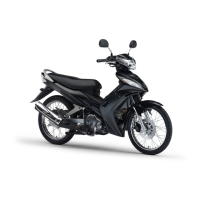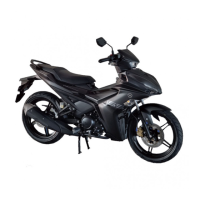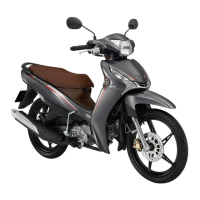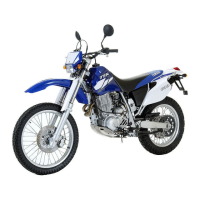Do you have a question about the Yamaha T135 and is the answer not in the manual?
Details about manual clutch and automatic transmission systems.
Defines Q, W, C symbols for safety, warnings, and cautions.
Describes the chapter titles and their placement within the manual.
Details the sequential, step-by-step procedure format used in the manual.
Explains symbols used for data, tools, part names, and fault conditions.
Notes that exploded diagrams precede disassembly sections for clarity.
Lists symbols indicating chapter subjects like General Information, Specifications, Engine, etc.
Lists symbols for serviceable items, fluids, tools, torque, wear limits, and data.
Explains symbols for different types of lubricants used in exploded diagrams.
Explains symbols for applying locking agents and replacing parts.
Explains how to find the vehicle identification number and engine serial number.
Covers preparation for disassembly, replacement parts, gaskets, seals, and fasteners.
Details procedures for inspecting and ensuring proper electrical connections.
Lists specific tools required for maintenance and assembly procedures.
Lists overall dimensions, weight, engine type, displacement, and fuel capacity.
Provides specific measurements and limits for engine, chassis, and electrical components.
Details where and what type of lubricants to use for engine and chassis components.
Illustrates the routing and connections of the cooling system components.
Shows the correct paths for routing various cables and hoses on the vehicle.
Explains the importance of preventive maintenance for reliable operation and longevity.
Provides a table outlining maintenance jobs and their recommended intervals based on odometer readings.
Describes the procedures for removing and installing various body covers like side, front, and rear cowlings.
Details checks and adjustments for engine components such as valve clearance, idling speed, oil level, and spark plug.
Covers checks and adjustments for chassis components including brakes, tires, drive chain, and steering head.
Outlines procedures for checking and maintaining the battery, fuses, and headlight system.
Explains the process of removing the engine from the vehicle, including related components.
Details the steps and torque specifications for reinstalling the engine assembly.
Covers removal, checking, and installation of the cylinder head and related parts.
Explains camshaft removal, checking, and installation procedures.
Details procedures for removing, checking, and installing valves and valve springs.
Covers radiator removal, checking, and installation.
Describes water pump removal, disassembly, checking, assembly, and installation.
Details the carburetor assembly components and their functions.
Step-by-step instructions for removing the carburetor from the motorcycle.
Procedures for taking apart the carburetor into its constituent parts.
Guides on inspecting carburetor body, passages, jets, and components for wear or damage.
Instructions for putting the carburetor back together, including float height adjustment.
Steps for refitting the assembled carburetor onto the motorcycle.
Explains how to check and adjust the TPS for proper engine operation.
Details how to verify the fuel cock is functioning correctly.
Covers air injection, cut-off valve, and related system diagrams and procedures.
Covers removal, checking, and installation of the front wheel and brake disc assembly.
Details rear wheel removal, brake shoe plate disassembly, and rear wheel installation.
Covers front brake caliper, pads, master cylinder removal, checking, and assembly.
Describes front fork leg removal, disassembly, checking, assembly, and installation.
Explains handlebar removal, checking, and installation procedures.
Covers lower bracket removal, steering head checking, and installation.
Details procedures for removing, checking, and installing the rear shock and swingarm.
Covers drive chain and sprocket removal, checking, and installation.
Lists and illustrates the location of key electrical components on the motorcycle.
Explains how to test switches for continuity using a pocket tester.
Guides on inspecting switches for damage, wear, connections, and continuity.
Details how to check bulbs and sockets for damage, continuity, and proper fit.
Covers the ignition system's circuit diagram and troubleshooting procedures.
Provides circuit diagram and troubleshooting for the electric starting system.
Details starter motor removal, disassembly, checking, assembly, and installation.
Covers the charging system's circuit diagram and troubleshooting.
Includes circuit diagrams and troubleshooting for headlights, taillights, and signals.
Provides circuit diagrams and troubleshooting for the horn, turn signals, and indicators.
Covers electrical aspects of the cooling system, including circuit diagrams and troubleshooting.
Explains the motorcycle's self-diagnostic system and fault codes.
Addresses common electrical faults and diagnostic steps.
Guides on diagnosing issues related to engine compression.
Covers troubleshooting for fuel, air, and exhaust systems.
The detailed circuit diagram showing all electrical connections and components.
Details about manual clutch and automatic transmission systems.
Defines Q, W, C symbols for safety, warnings, and cautions.
Describes the chapter titles and their placement within the manual.
Details the sequential, step-by-step procedure format used in the manual.
Explains symbols used for data, tools, part names, and fault conditions.
Notes that exploded diagrams precede disassembly sections for clarity.
Lists symbols indicating chapter subjects like General Information, Specifications, Engine, etc.
Lists symbols for serviceable items, fluids, tools, torque, wear limits, and data.
Explains symbols for different types of lubricants used in exploded diagrams.
Explains symbols for applying locking agents and replacing parts.
Explains how to find the vehicle identification number and engine serial number.
Covers preparation for disassembly, replacement parts, gaskets, seals, and fasteners.
Details procedures for inspecting and ensuring proper electrical connections.
Lists specific tools required for maintenance and assembly procedures.
Lists overall dimensions, weight, engine type, displacement, and fuel capacity.
Provides specific measurements and limits for engine, chassis, and electrical components.
Details where and what type of lubricants to use for engine and chassis components.
Illustrates the routing and connections of the cooling system components.
Shows the correct paths for routing various cables and hoses on the vehicle.
Explains the importance of preventive maintenance for reliable operation and longevity.
Provides a table outlining maintenance jobs and their recommended intervals based on odometer readings.
Describes the procedures for removing and installing various body covers like side, front, and rear cowlings.
Details checks and adjustments for engine components such as valve clearance, idling speed, oil level, and spark plug.
Covers checks and adjustments for chassis components including brakes, tires, drive chain, and steering head.
Outlines procedures for checking and maintaining the battery, fuses, and headlight system.
Explains the process of removing the engine from the vehicle, including related components.
Details the steps and torque specifications for reinstalling the engine assembly.
Covers removal, checking, and installation of the cylinder head and related parts.
Explains camshaft removal, checking, and installation procedures.
Details procedures for removing, checking, and installing valves and valve springs.
Covers radiator removal, checking, and installation.
Describes water pump removal, disassembly, checking, assembly, and installation.
Details the carburetor assembly components and their functions.
Step-by-step instructions for removing the carburetor from the motorcycle.
Procedures for taking apart the carburetor into its constituent parts.
Guides on inspecting carburetor body, passages, jets, and components for wear or damage.
Instructions for putting the carburetor back together, including float height adjustment.
Steps for refitting the assembled carburetor onto the motorcycle.
Explains how to check and adjust the TPS for proper engine operation.
Details how to verify the fuel cock is functioning correctly.
Covers air injection, cut-off valve, and related system diagrams and procedures.
Covers removal, checking, and installation of the front wheel and brake disc assembly.
Details rear wheel removal, brake shoe plate disassembly, and rear wheel installation.
Covers front brake caliper, pads, master cylinder removal, checking, and assembly.
Describes front fork leg removal, disassembly, checking, assembly, and installation.
Explains handlebar removal, checking, and installation procedures.
Covers lower bracket removal, steering head checking, and installation.
Details procedures for removing, checking, and installing the rear shock and swingarm.
Covers drive chain and sprocket removal, checking, and installation.
Lists and illustrates the location of key electrical components on the motorcycle.
Explains how to test switches for continuity using a pocket tester.
Guides on inspecting switches for damage, wear, connections, and continuity.
Details how to check bulbs and sockets for damage, continuity, and proper fit.
Covers the ignition system's circuit diagram and troubleshooting procedures.
Provides circuit diagram and troubleshooting for the electric starting system.
Details starter motor removal, disassembly, checking, assembly, and installation.
Covers the charging system's circuit diagram and troubleshooting.
Includes circuit diagrams and troubleshooting for headlights, taillights, and signals.
Provides circuit diagrams and troubleshooting for the horn, turn signals, and indicators.
Covers electrical aspects of the cooling system, including circuit diagrams and troubleshooting.
Explains the motorcycle's self-diagnostic system and fault codes.
Addresses common electrical faults and diagnostic steps.
Guides on diagnosing issues related to engine compression.
Covers troubleshooting for fuel, air, and exhaust systems.
The detailed circuit diagram showing all electrical connections and components.
| Brand | Yamaha |
|---|---|
| Model | T135 |
| Category | Motorcycle |
| Language | English |











